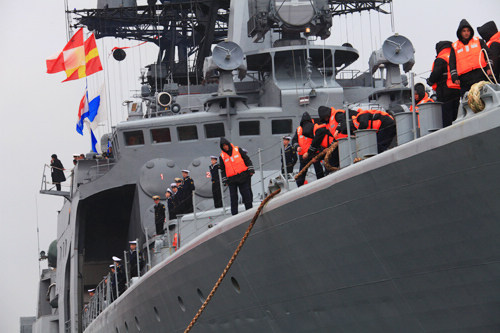|
 |
|
ARRIVAL: The warshipAdmiral Vinogradov, an Udaloy-class destroyer of Russia's Pacific Fleet, arrives at the Qingdao port, east China's Shandong Province, on April 21, to participate in the joint naval drill in the Yellow Sea (ZHA CHUNMING) |

Between April 22 and 27, China and Russia conducted joint naval exercises in the waters of the Yellow Sea off China's east coast for the first time, signifying the growing cooperation under the China-Russia strategic partnership.
The six-day joint drill involved 16 surface vessels and two submarines from the Chinese People's Liberation Army (PLA) Navy and four warships as well as three supply ships from the Russian Pacific Fleet. The Russian Pacific Fleet's flagship Varyag, a Slava-class heavy missile cruiser participated in the exercise, along with Shenyang, the most advanced missile destroyer in the PLA Navy. The main forces from both navies participating in the drill reflected its great importance.
General Qian Lihua, Director of the Foreign Affairs Office with the National Defense Ministry, said the exercise focused on the defense of air routes and maritime traffic routes, search and rescue operations and anti-submarine tactics, as well as joint rescues of hijacked vessels.
"Joint military exercises have grown to be a regular form of cooperation between China and Russia in recent years. The 2012 joint naval drill is a routine arrangement within the framework of bilateral military cooperation," Qian said. "And the drill is not targeted at any third party."
Though China and Russia have conducted four bilateral and multilateral military exercises since 2005, all of them were carried out within the framework of the Shanghai Cooperation Organization, a grouping for regional peace that includes China, Russia and four Central Asian states. The latest naval drill was a breakthrough for China and Russia to hold a large combat exercise in the bilateral framework, fulfilling the commitment to strengthening their strategic partnership.
The joint naval exercise also has some obvious distinctions by contrast with past events. First of all, it is the largest joint exercise conducted by the two nations, with a total of 25 vessels, 22 aircraft and nearly 10,000 soldiers. The unprecedented marine array was co-led by Ding Yiping, Deputy Commander of the PLA Navy, and Rear Admiral Leonid Sukhanov, Russian naval deputy chief of staff.
PLA Chief of General Staff, General Chen Bingde, said the joint naval exercise aims to counter new challenges and threats together with Russia and secure the peace and stability in the Asia-Pacific region, showing the resolution of China and Russia to rebalance the power structure in the region. This is the first time that the Chinese military has expressed such a purpose for a joint drill. The Chinese Navy previously held joint drills with other countries only for the subject of unconventional security or fighting terrorism.
"After consultations with our partner, Russia, the joint drill sets four objectives as follows," said Ding. "We expect to solidify the strategic partnership between the two parties, deepen the practical cooperation between the two militaries, improve the capability of carrying out joint military actions, and strengthen the confidence of securing the peace and stability in related regions through the joint naval drill."
Chen Guangwen, an independent military expert, said, "The participation of Russia's flag warship Varyag and other heavy destroyers means the joint anti-submarine mission is the most important task for the naval exercise."
|
